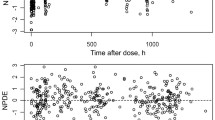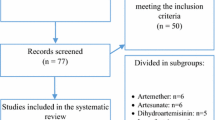Abstract
Objective
To determine the pharmacokinetic properties of dihydroartemisinin (DHA) following oral artesunate treatment in women with recrudescent multi-drug resistant falciparum malaria, in the second and third trimesters of pregnancy.
Methods
Serial plasma concentrations of artesunate and DHA were measured in 24 women after the final dose of a 3 day treatment with artesunate (4 mg kg−1 day−1) and atovaquone (20 mg kg−1 day−1) plus proguanil (8 mg kg−1 day−1), daily. Conventional non-compartmental modelling and a population one-compartment pharmacokinetic model were applied to the data.
Results
Artesunate was very rapidly eliminated. For DHA the median [90% range] estimate of oral clearance (CI/F) was 4.0 [0.8–20.7] l hour−1 kg−1, total apparent volume of distribution (Vd/f) was 3.4 [0.9–60.7] l/kg, and terminal elimination half-life was 1.0 [0.6–2.4] h.
Conclusion
The kinetics of DHA are modified by pregnancy. The plasma levels of the active antimalarial metabolite DHA are lower than reported previously in non-pregnant adults. Dose-optimisation studies in pregnant women are needed.

Similar content being viewed by others
References
McGready R, Nosten F(1999) The Thai-Burmese border: drug studies of Plasmodium falciparum in pregnancy. Ann Trop Med Parasitol 93 [Suppl 1]: S19–S23
McGready R, Cho T, Keo NK, Thwai KL, Villegas L, Looareesuwan S, White NJ, Nosten F (2001) Artemisinin antimalarials in pregnancy: a prospective treatment study of 539 episodes of multidrug-resistant Plasmodium falciparum. Clin Infect Dis 33:2009–2016
Angus BJ, Thaiaporn I, Chanthapadith K, Suputtamongkol Y, White NJ (2002) Oral artesunate dose-response relationship in acute falciparum malaria. Antimicrob Agents Chemother 46:778–782
McGready R, Stepniewska K, Edstein MD, Cho T, Gilveray G, Looareesuwan S, White NJ, Nosten F (2003) The pharmacokinetics of atovaquone and proguanil in pregnant women with acute falciparum malaria. Eur J Clin Pharmacol 59:545–552
van Vugt M, Edstein MD, Proux S, Lay K, Ooh M, Looareesuwan S, White NJ, Nosten F (1999) Absence of an interaction between artesunate and atovaquone–proguanil. Eur J Clin Pharmacol 55:469–474
Nosten F, van Vugt M, Price R, Luxemburger C, Thway KL, Brockman A, McGready R, ter Kuile F, Looareesuwan S, White NJ (2000) Effects of artesunate-mefloquine combination on incidence of Plasmodium falciparum malaria and mefloquine resistance in western Thailand: a prospective study. Lancet 356:297–302
Khanh NX, de Vries PJ, Ha LD, van Boxtel CJ, Koopmans R, Kager PA (1999) Declining concentrations of dihydroartemisinin in plasma during 5-day oral treatment with artesunate for Falciparum malaria. Antimicrob Agents Chemother 43:690–692
Hassan Alin M, Ashton M, Kihamia CM, Mtey GJ, Bjorkman A (1996) Multiple dose pharmacokinetics of oral artemisinin and comparison of its efficacy with that of oral artesunate in falciparum malaria patients. Trans R Soc Trop Med Hyg 90:61–65
Rolan PE, Mercer AJ, Weatherley BC, Holdich T, Meire H, Peck RW, Ridout G, Posner J (1994) Examination of some factors responsible for a food-induced increase in absorption of atovaquone. Br J Clin Pharmacol 37:13–20
Na-Bangchang K, Congpuong K, Hung LN, Molunto P, Karbwang J (1998) Simple high-performance liquid chromatographic method with electrochemical detection for the simultaneous determination of artesunate and dihydroartemisinin in biological fluids. J Chromatogr B Biomed Sci Appl 708:201–207
Navaratnam V, Mordi MN, Mansor SM (1997) Simultaneous determination of artesunic acid and dihydroartemisinin in blood plasma by high-performance liquid chromatography for application in clinical pharmacological studies. J Chromatogr B Biomed Sci Appl 692:157–162
McGready R, Brockman A, Cho T, Cho D, van Vugt M, Luxemburger C, Chongsuphajaisiddhi T, White NJ, Nosten F (2000) Randomized comparison of mefloquine-artesunate versus quinine in the treatment of multidrug-resistant falciparum malaria in pregnancy. Trans R Soc Trop Med Hyg 94:689–693
Hien TT, White NJ (1993) Qinghaosu. Lancet 341:603–608
Nosten F, Luxemburger C, Ter KF, Woodrow C, Eh JP, Chongsuphajaisiddhi T, White NJ (1994) Treatment of multidrug-resistant Plasmodium falciparum malaria with 3- day artesunate-mefloquine combination. J Infect Dis 170:971–977
White N (1999) Antimalarial drug resistance and combination chemotherapy. Philos Trans R Soc Lond B Biol Sci 354:739–749
Assessment of the safety of artemisinin compounds in pregnancy (2003) World Health Organization WHO/CDS/MAL/2003.1094
Teja-Isavadharm P, Watt G, Eamsila C, Jongsakul K, Li Q, Keeratithakul G, Sirisopana N, Luesutthiviboon L, Brewer TG, Kyle DE (2001) Comparative pharmacokinetics and effect kinetics of orally administered artesunate in healthy volunteers and patients with uncomplicated falciparum malaria. Am J Trop Med Hyg 65:717–721
Newton P, Suputtamongkol Y, Teja-Isavadharm P, Pukrittayakamee S, Navaratnam V, Bates I, White N (2000) Antimalarial bioavailability and disposition of artesunate in acute falciparum malaria. Antimicrob Agents Chemother 44:972–977
van Agtmael MA, Cheng-Qi S, Qing, JX, Mull R. van Boxtel CJ (1999) Multiple dose pharmacokinetics of artemether in Chinese patients with uncomplicated falciparum malaria. Int J Antimicrob Agents 12:151–158
Simonsson US, Jansson B, Hai TN, Huong DX, Tybring G, Ashton M (2003) Artemisinin autoinduction is caused by involvement of cytochrome P450 2B6 but not 2C9. Clin Pharmacol Ther 74:32–43
Acknowledgements
We thank the pregnant women who participated in the study, the staff of the Shoklo Malaria Research Unit in-patient department and antenatal clinics for their help. We are grateful to P. Newton for his comments on the manuscript. Drug analyses were performed through the Wellcome Trust funded LOTLink initiative. This investigation was part of the Wellcome Trust Mahidol University Oxford Tropical Medicine Research Programme supported by the Wellcome Trust of Great Britain.
Author information
Authors and Affiliations
Corresponding author
Rights and permissions
About this article
Cite this article
McGready, R., Stepniewska, K., Ward, S.A. et al. Pharmacokinetics of dihydroartemisinin following oral artesunate treatment of pregnant women with acute uncomplicated falciparum malaria. Eur J Clin Pharmacol 62, 367–371 (2006). https://doi.org/10.1007/s00228-006-0118-y
Received:
Accepted:
Published:
Issue Date:
DOI: https://doi.org/10.1007/s00228-006-0118-y




